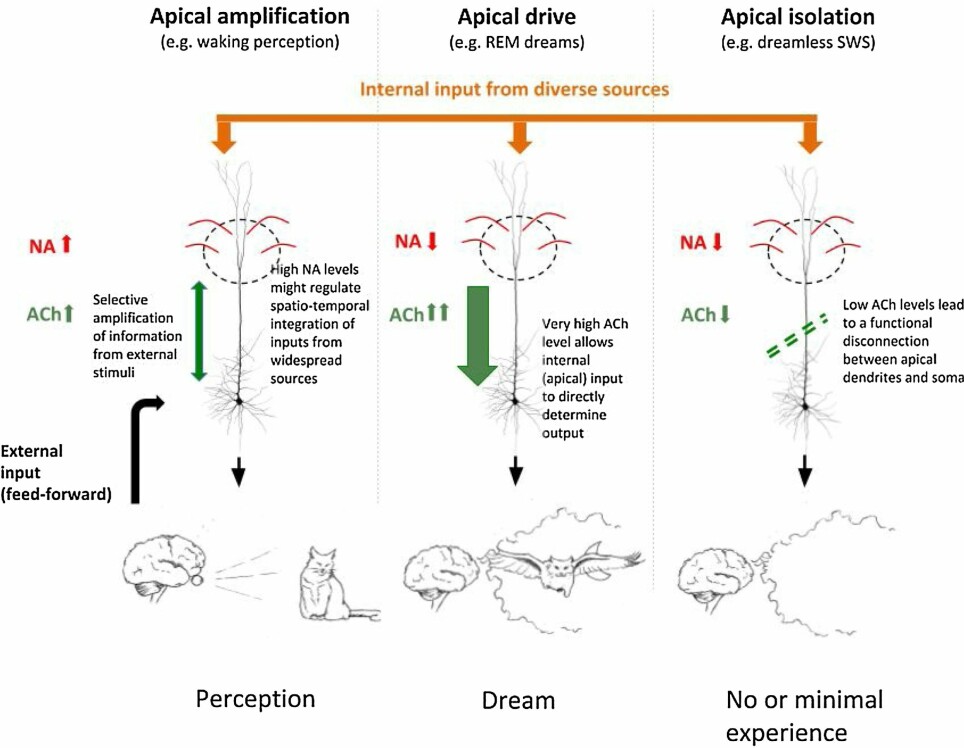
Researchers may have discovered where dreams come from
Brain cells that receive sensory stimuli while we’re awake may be activated by memories when we sleep.
Every night your inner eye is met with lifelike movies, with you in the leading role. It all seems real before we wake up, even if what we're doing is both irrational and absurd.
Whether you're jumping from skyscrapers, getting a bear to babysit or flirting with Hollywood superstars, it all seems totally natural while you're asleep.
Dreams are like lifelike hallucinations. They have fascinated us since ancient times.
But how does the brain manage to create such vivid imagery while we sleep?

Creates imagery without new sensory stimuli
“One of the strangest things is that we experience dreams as real while we’re asleep with our eyes closed, isolated from the outside world, and not receiving any new sensory stimuli,” says Johan Frederik Storm, a doctor and professor at the Institute of Basic Medical Sciences at the University of Oslo.
Storm does research on brain signals with colleagues from Germany, Scotland and Switzerland. They recently launched a new theory about how dreams arise in brain cells.
The theory is that dreams occur in the same cells in the cerebral cortex that receive the sensory stimuli through which we experience the real world when we’re awake.
How do dreams happen?
When we sleep, these brain cells are activated by internal information in a different way.
“These cells are in a completely different state when we dream, which means that they’re driven by information from the brain's internal stores, instead of being activated by new sensory input from the real world,” Storm explains.
The researchers’ theory was recently published in Neuroscience & Biobehavioral Reviews.
The theory focuses on what happens inside our brain cells when we dream, in the context of brain processes as a whole that create dreams and conscious experiences.
Cerebral cortex is key
According to the researchers, dreams arise in the cerebral cortex, which is the outer layer of the cerebrum.
The cells here are what we use to think and perceive with. The largest of these cells are called pyramidal cells, or pyramidal neurons. They resemble trees, with roots, trunks and branches called dendrites.
When we’re awake, the "roots" collect sensory stimuli through the eyes, ears and other sensory organs.
But to understand what these impressions mean, they have to be interpreted in light of what we know about the world otherwise.
“This understanding happens because the same cells take in information from outer sensory stimuli and from memory, which is sent to the "tree crown" at the very top of the cell,” Storm says.
“We believe that the sensory stimuli coming in at the cells' "roots" are consciously perceived only when the cell has interpreted them by comparing them with the information at the treetop, at the opposite end of the cell,” Storm tells ScienceNorway.no.
Why are dreams experienced as real?
The new theory is that the tree crown – the top of the pyramidal neurons – drives the dreams.
Researchers call this apical drive, which means that the cells are "top driven" when we dream.
“We think the reason we experience dreams as real is that the pyramidal neurons send out internally driven signals that are confusingly similar to waking signals driven by real external sensory stimuli,” says Storm.
The basis of this internal information is the experience and knowledge of the world that we learn and collect throughout our lives and store in our memory.

Awake brain makes model of the world by guessing
"Even when we take information from real sensory stimuli directly into the cell roots in an awake state, the information is very difficult to interpret and basically completely incomprehensible to the brain,” Storm says.
“But the pyramidal neurons can recognize patterns in the signals by comparing them with patterns stored in memory. This is how the brain can guess what we perceive, like recognizing a cup, a house or a human being,” says Storm.
This is how the brain builds up an internal model of the outer world, by assembling and interpreting the sensory signals from the sensory organs, he says.
The brain thus uses previous experience to interpret what we see, smell, taste or hear, he says.
In an awake state, the cerebral cortex receives most of its information through the roots of the pyramidal cells.
“But when we sleep, this information flow to the roots is turned almost all the way off,” Storm says.
Exciting research
Dream researcher Roar Fosse thinks the theory is inspiring.
“This is an exciting contribution from Johan Storm and his colleagues about cellular processes that can be key components in our dreams,” says Fosse, who holds a doctorate in dreaming.
Fosse believes the new theory fits in well with existing knowledge about the neurological basis of dreaming, especially in REM sleep. We know that dreaming draws on large parts of the sensory networks in the brain that are involved when we perceive the outside world in a waking state, he says.
“We know a lot about how these networks work in a different way during dreams, but it isn’t easy to take this knowledge to the next level. But that’s exactly what I think Storm and his colleagues are doing with their model,” says Fosse, who is a psychologist at Vestre Viken health trust.
Expectations
Fosse cites expectations as a way to explain the content of our dreams, according to research of other brain researchers.
“The researchers have assumed that when we expect something, but where sensory stimuli aren’t reaching the brain, the expectations can develop into sensory experiences – and appear as psychotic hallucinations or as dreams when we sleep,” he says and refers to British brain researcher Karl J. Friston's theories.
Like Storm, Friston has also pointed to the central function of pyramidal neurons deep in the cerebral cortex.
“Storm and his colleagues outline how sleep provides a different form of functioning in these cell components, which means that our experiences and expectations emerge as inwardly evoked sensory-based experiences and dreams. It’s exciting and makes a lot of sense,” he says.
Fosse hopes their further research will also reveal the importance of other neurotransmitters in the brain, such as dopamine, serotonin and GABA.
“It would also be very exciting if they could expand the model to include the form of activity that seems to characterize REM sleep, which is probably about orientation waves that emerge from the brain stem,” he says.
This is the same kind of activity we see when we’re alerted to sudden noises and other events in our surroundings while we’re awake, says Fosse.
Neurotransmitter level changes during REM sleep
We dream the most during so-called REM (rapid eye movement) sleep, when our eyes move quickly underneath our eyelids.
According to the new theory, we dream the most during REM sleep because the concentration of a special neurotransmitter in the cerebral cortex, acetylcholine, is even higher during REM sleep than otherwise.
“This substance triggers a powerful reinforcement mechanism at the top end of the pyramidal neurons, at the same time as other signal substances are changing too. At the same time, the sensory information of the roots from the external world weakens,” says Storm.
“In other words, internally generated information takes over and drives the cells' activity. This is what we call apical drive,” he says.
But we don’t dream only during REM sleep.
“We know that we also dream when we sleep more deeply. But the dreams that we can remember if we wake up during this deep sleep phase are typically less vivid than REM sleep dreams,” says Storm.
Everyone dreams, but some people dream more or remember their dreams better than others. Many people who think they rarely dream have a harder time remembering dreams when they wake up.
French researchers have previously identified certain characteristics in people who remember more dreams and more detailed dreams than others.
Dreaming while under anaesthesia
Recent studies, including from Storm's research group, have shown that even patients under normal anaesthesia often dream, although they tend to forget the dreams quite quickly after waking up from the anaesthesia.
Psychedelic drugs and other hallucinogenic drugs can cause hallucinations when awake, which resemble dreams.
“It’s interesting that some of these substances have a special effect on molecular mechanisms at the top of the pyramidal neurons, and can thus affect the dream mechanism that we’re proposing,” says Storm.
Nadine Farnes, Bjørn Juel and Andre Nilsen in Storm's group have collaborated with anaesthesiologists at Oslo University Hospital, Rikshospitalet to study how ketamine affects both the brain signals and experiences of the study subjects.
Ketamine is a sedative and hallucinogenic drug that is used before anaesthesia, and which is now also approved for use for depression.
Can dreams improve brain's internal model of the world?
Researchers are still unsure of what functions dreams have. The topic is controversial and was discussed by leading experts in the Forum for Consciousness Research in Oslo in 2019.
Storm and the other researchers behind the study discuss new proposals in their article, including being inspired by artificial intelligence and machine learning.
“An interesting possibility is that dreams can serve to explore, complement and improve the brain's internal model of the outer world,” he says.
In dreams, the brain can test new combinations of sensory input that we can never or rarely experience while awake.
“This may explain why a lot of dreams seem so absurd and different from our real experiences,” says Storm.
Researchers believe that this function may be an important basis for our imagination, fantasy and planning ability.
These abilities are especially highly developed in human beings.
"The new mechanism that we propose in our dream theory, apical drive, may actually be even more important in our waking state than in dreams,” Storm says.
Mechanism could also be important when awake
“When we’re awake, we spend a lot of time thinking abstractly about things that we’re not perceiving in the here and now, rather things we remember, imagine, plan, fantasize or daydream about,” says Storm.
In all these cases, brain cells mostly use internal information, much more than current sensory impressions. And it’s likely that apical drive is used to amplify the internal information then. But in our normal, awake state, the mechanism is probably never as overwhelmingly strong as when we dream.
When we’re awake, sensory stimuli aren’t weakened like when we sleep, so we don’t confuse our imagination with the real world, he says.
Storm hopes the theory they have developed is the start of something bigger.
The researchers hope to gain a deeper understanding of how the cerebral cortex works, not only in dreams, but also when thinking in a wakeful state, “and especially of highly developed abilities for planning, abstract performances, creativity and imagination,” says Storm.
Testing the theory on animals and humans
This new theory has come together by building on the results of studies on both humans and animals, from many research groups and using different methods.
To test different parts of the theory, Storm's group will run animal experiments to study the signals inside the brain in detail as well as experiments on human volunteers.
The group will measure and compare the activity in the upper and deepest layers of the cerebral cortex of volunteer subjects in their dreaming, deep sleep and awake states.
The research will be carried out at the University of Glasgow using powerful magnetic fields that can capture very high resolution images of brain activity.
This method will enable the researchers to distinguish between the signals at the "roots" and at the "treetops" of the large pyramidal neurons and will test some important aspects of the theory.
Translated by: Ingrid P. Nuse
Reference:
Jaan Aru et.al.: Apical drive - a cellular mechanism of dreaming?, Neuroscience & Biobehavioral Reviews, 2020.
———
Read the Norwegian version of this article at forskning.no
































